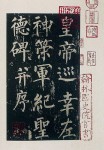Two Masters of the Tang Dynasty
During the Tang Dynasty, calligraphic style changed and developed. In href=”http://www.chinascan.org/archives/900/jiucheng-palace-tabletwrittern-in-regular-script-by-ouyang-xun”> Buy Cialis Super Active+ Online alt=”Jiucheng Palace Tablet,writtern in regular script by Ouyang Xun” width=”69″ height=”122″ />this chapter, we will introduce Chu Suiliang and Yan Zhenqing, the two leaders of the trend in calligraphy trend at that time. In the early years of the Tang Dynasty, there were four famous calligraphers: Ouyang Xun, Yu Shinan, Chu Suiliang and Xue Ji, in order of their ages.
Buy Cialis Super Active+ Online alt=”Jiucheng Palace Tablet,writtern in regular script by Ouyang Xun” width=”69″ height=”122″ />this chapter, we will introduce Chu Suiliang and Yan Zhenqing, the two leaders of the trend in calligraphy trend at that time. In the early years of the Tang Dynasty, there were four famous calligraphers: Ouyang Xun, Yu Shinan, Chu Suiliang and Xue Ji, in order of their ages.
Chu Suiliang (596-658) was once an official of the imperial court, and wrote the draft declaration made by Emperor Taizong when he abdicated in favor of his son. When the new emperor, Gaozong, married Wu Zetian, one of his father’s concubines, Chu protested, and was exiled from the capital.
Preface to Tripitaka, written in regular script by Chu Suiliang. Chu studied the calligraphic styles of Ouyang Xun and Wang Xizhi, and the Han official script. He combined all these into a new type of script, abandoning the”silkworm’s head” and “wild goose’s tail.” His calligraphic style underwent three major changes. The Preface to Tripitake is one of his masterpieces. Written in the regular script, the characters are thin and smooth, but powerful. It became fashionable to copy his handwriting, and he himself was praised as a calligraphy master of the Tang Dynasty.
Yan Zhenqing (708-784) was born into an aristocratic family. His grandfather and paternal uncle were calligraphers, and instilled a love of calligraphy into him. Yan passed the highest imperial examination and became an official for a time. His powerful and vigorous handwriting in the regular or running scripts reflect his lofty moral character.
At first, Yan copied Chu’s style, and later Wang Xizhi’s. He finally developed a powerful, fantastic and beautiful style, which was in harmony with the flourishing culture of the powerful Tang Dynasty. His style has been enthusiastically followed by later generations.
Here we should introduce Liu Gongquan (778-865) who was born 70 years later, and became as famous as Yan, whose style he studied.
Liu Gongquan received encouragement from several emperors, who were his patrons. Liu’s characters are powerful, vigorous and smooth, and the strokes extend outward. He is famous for his command of tension and the cohesion of his ink. Like Yan’s, Liu’s calligraphy has been copied widely by people of later generations.
patrons. Liu’s characters are powerful, vigorous and smooth, and the strokes extend outward. He is famous for his command of tension and the cohesion of his ink. Like Yan’s, Liu’s calligraphy has been copied widely by people of later generations.
Rigor is the most important characteristic of the calligraphers of the Tang Dynasty. The Tang style is quite different from that of the Jin Dynasty, which is elegant, graceful, unrestrained and beautiful, while that of the Tang Dynasty is strict and neat, and easy to learn. From the Tang Dynasty on, calligraphy became an art involving many more people.